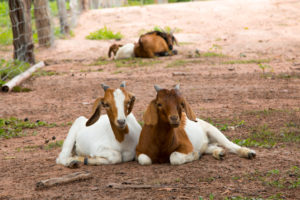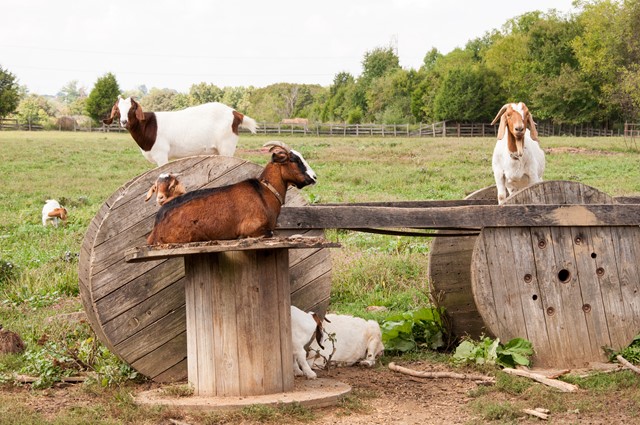Raising goats can be both a profitable and rewarding activity for landowners as they are a fascinating species of animal. They can eat a wide range of forages (trees, shrubs, forbs, and grasses) and can produce meat, milk, and for some breeds, fiber such as mohair or cashmere. For the urban small landowner, they offer an agricultural enterprise that can not only generate income, but can qualify your agricultural acreage for a reduced property tax rate. Below are some of the most frequently asked questions about raising and caring for goats:
What are some of the challenges to raising and caring for goats?
First and foremost, the biggest challenge is keeping them where you want them. They are very curious and intelligent animals and are always looking for what’s just outside their fence. A good net wire fence is very important to keep them in and help keep predators out. While goats do jump, they are more prone to go under, or through, a fence, so monitoring their enclosures is a major part of raising these animals.
Predation is also a constant problem, especially with young kids. As mentioned before, a good fence is helpful as a barrier. Guard animals, such as dogs, llamas, or donkeys, have been beneficial for many goat raisers. Use of a qualified trapper can also be of help with larger acreages to help with predator control.
What type of shelter do goats require?
Like most other animals, goats require protection from extreme heat and cold in the form of shade and windbreaks. On larger acreages, brush species like juniper, oak, and others can provide protection from weather. Without trees and brush, they should have some type of shelter, such as sheds or barns, that will give them protection. Sometimes in very cold weather, goats can crowd together and animals can suffocate from being trampled, especially very young kids with their dams. Building a barrier that kid goats can get past but keeps out older goats, can allow them to have protection from trampling in extreme conditions. Barns and sheds should also have air flow through them in very hot weather to provide a cooling effect.
How many goats per acre are recommended?
The answer depends on how much forage you have available for them to eat. Plants that goats eat are a renewable resource in that as long as it rains during their growing season, the plants can produce new growth. However, if you have more forage demand than the plants are capable of producing, the plants will begin to die out from overgrazing. The first plants to begin to diminish and die will be the preferred forages, which are generally the most nutritious plants in the grazing area. When these plants die out, lesser plants, with lesser nutrient value, will grow. With continued overgrazing, the majority of the plants that remain will be those with low nutrient value that the goats do not want to eat, or that could be potentially toxic. Monitoring the plants in your grazing area will help you to determine how many goats utilize this area without decreasing its productivity.
What kind of feeding regimen is needed for goats?
Unlike most people’s perception, a goat will not, and cannot, “eat anything”. Actually, they are very selective and need a diet that is higher in nutrient density than larger animals, such as cattle or horses. While they do eat a wide variety of plants, they will first consume the most nutritious. Fresh, green forages are the best, and most economical, diet. They have a high preference for trees and shrubs they can reach, but will eat forbs (what most people call “weeds”) and short grasses. Tall grasses tend to be too high in fiber and are not as digestible to a goat as they are to a cow. Young, growing kid goats weaned from their mother need a higher level of nutrition than mature goats that are not lactating or are in early pregnancy. Does in late pregnancy (the last 50 days of pregnancy) and lactation (producing milk) also need a high level of nutrients in their diet.
Quality hays such as early cut grasses like Bermuda grass or alfalfa and clover can be used to enhance your grazing forage and provide needed nutrients. These can be higher in quality than the grazing plants you may have. Just remember that hays for goats needs to be cut earlier than for cows to have the high level of digestibility required.
Goats may require supplements for protein and/or energy when the forage, or hay, that they are consuming is lower than the requirements for the goats’ stage of reproduction, or growth. Many times forages and hays may have mineral deficient levels for goats, and other livestock. In these cases, mineral supplements should be made available to help the goats correct those deficiencies with a free-choice intake.
For our goat product info, click here.

Do goats being raised for milk need special nutrient requirements?
The answer is yes. Milk production creates the greatest nutrient requirement for mature goats. The amount of milk produced by the doe directly affects the levels of protein, energy, and minerals needed each day. Dairy goats produce two to three times the amount of milk that a meat goat produces, so their diet intake and nutrient requirements are much greater than for one that is not producing milk. Also, when meat goats have multiple births, the amount of milk they produce increases significantly, and their diet intake and nutrient requirements increase as well. The best indicator of whether the does are getting enough nutrients for their demand is to monitor their body condition. If their backbone and hip bones are beginning to show more prevalently, they are not getting a sufficient nutrient intake to maintain their body weight and are having to metabolize body tissues, muscle and fat, for protein and energy sources to produce milk. When this occurs, their diet intake should be increased and/or supplemented to prevent excessive weight loss.
How should goats be watered?
Goats, like all ruminant animals, have an essential requirement for clean, abundant water. They do not drink well when water is dirty or very hot. This is compounded by the fact that they are notorious for fouling their water source, so monitoring their water source and making sure they are drinking well is very important for overall health and well-being. Clean water troughs often – sometimes daily. Also, make sure there is plenty of water available at all times. It is very important in winter to make sure water is available and not frozen.
What regular health care needs do goats have?
Goats are susceptible to many diseases, but fortunately there are many vaccines and antibiotics that are available to protect them. Developing a relationship with a veterinarian is essential to help you learn what potential problems are prevalent in your area and to create a plan to give your animals as much protection as possible. Ensuring that they are receiving the nutrition they need is one of the best management tools to maintain their health.
Is grooming, or bathing, required for goats?
Most goats do not require much in the way of grooming. Sometimes they may need their hooves trimmed if they do not wear them down naturally. Otherwise, they are a self-sustaining animal. However, if you are involved in showing animals, or selling show animals, then grooming and bathing may be required to present them in their best condition. Remember that washing goats removes natural oils and they should be dried sufficiently to keep them from being chilled in colder weather.
Do goats need to be socialized, or trained when they are young?
Socializing and training of young goats will be required if you are going to show goats for competition or sale. Teaching a goat to interact with strange goats and stand correctly, as it will have to in the show ring, will help you show present the goat at its best. This training is time consuming and a part of showmanship, but is essential to placing well in the show ring.
For all our goat feed and mineral supplement information, click here.
Have a question about raising goats? Ask our experts!


